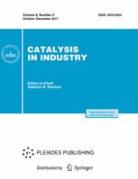Bacterial Degradation of Ecotoxic Dehydroabietic Acid
https://doi.org/10.18412/1816-0387-2017-2-153-160
Abstract
Actinobacterial strain Dietzia maris IEGM 55Twas used for studying biodegradability of dehydroabietic acid (C20H28O2, САS: 1740-19-8, abieta- 8,11,13-trien-18-oic acid, DAC) – a toxic tricyclic diterpenoid accumulated in wastewater of paper-and-pulp industry. A pronounced stability(MIC 390 mg/L) of Dietzia maris IEGM 55Т cells with respect to DAC was revealed. It was established that dietzia do not use DAC as an only source of carbon and energy, practically complete (97 %) destruction of 500 mg/L DAC being observed in 7 days under conditions of pre-cultivation of dietzia in the presence of n-hexadecane. The influence of DAC on the vital capacity and respiratory activity of dietzia was studied. The method of determination of antimicrobial activity was used to show that extracts of the prepared metabolites are not apparently toxic in comparison to that of the initial substrate. The data obtained expand the knowledge on the catalytic activity of actinobacteria and on their potential contribution to decontamination of natural ecosystems from ecotoxicants.
About the Authors
K. M. CheremnykhRussian Federation
V. V. Grishko
Russian Federation
I. B. Ivshina
Russian Federation
References
1. Liss N., Bicho A., Saddler N. // Can. J. Microbiol. 1997. Vol. 75. P. 599—611.
2. Peng G., Roberts J. // Water Res. 2000. Vol. 34. № 10. P. 2779—2785.
3. Kamaya Y., Tokita N., Suzuki K. // Ecotoxicol. Environ. Saf. 2005. Vol. 61. P. 83—88.
4. Hernandez V., Silva M., Gavilan J., Jimenez B., Barra R., Becerra J. // J. Chil. Chem. Soc. 2008. Vol. 53. № 4. P. 1718—1721.
5. Biellmann J.F., Branlant G. Gero-Robert M., Poiret M. // Tetrahedron Lett. 1973. Vol. 29. P. 1227—1236.
6. Mohn W.W. // Appl. Environ. Microbiol. 1995. Vol. 61. P. 2145— 2150.
7. Mohn W.W., Yu Z., Moore E.R.B., Muttray A.F. // J. Ind. Microbiol. Biotechnol. 1999. Vol. 23. P. 374—379.
8. Muttray A.F., Yu Z., Mohn W.W. // FEMS Microbiol. Ecol. 2001. Vol. 38. P. 21—31.
9. Kutney J.P., Dimitriadis E., Hewitt G.M., Salisbury P.J., Singh M., Servizi J.A., Martens D.W., Gordon R.W. // Helv. Chim. Acta. 1982. Vol. 65. P. 1343—1350.
10. Morgan C.A., Wyndham R.C. // Can. J. Microbiol. 2002. Vol. 48. P. 49—59.
11. Smith D.J., Martin J.J., Mohn W.W. // J. Bacteriol. 2004. Vol. 186. № 11. P. 3631—3639.
12. Bicho P.A., Martin V., Saddler J.N. // Appl. Environ. Microbiol. 1995. Vol. 61. P. 3245—3250.
13. Choudhary M.I., Atif M., Ali-Shah S.A., Sultan S., Erum S., Khan S.N., Rahman A.U. // Int. J. Pharm. Pharm. Sci. 2014. Vol. 6. № 7. P. 375—378.
14. Gouiric S.C., Feresin G.E., Tapia A.A., Rossomando P.C., Scheda-Hirschmann G., Bustos D.A. // World J. Microbiol. Biotechnol. 2004. Vol. 20. P. 281—284.
15. Beek T.A., Claassen F.W., Dorado J., Godejohann M., Sierra- Alvarez R., Wijnberg J.B.P.A. // J. Nat. Prod. 2007. Vol. 70. P. 154—159.
16. De Carvalho C.C.С.R., Fatal V., Alves S.S., da Fonseca M.M. // Appl. Microbiol. Biotechnol. 2007. Vol. 76. P. 1423–1440.
17. Alonso-Gutiérrez J., Teramoto M., Yamazoe A., Harayama S., Figueras A., Novoa B. // J. Appl. Microbiol. 2011. Vol. 111. № 4. P. 800—810.
18. Донова М.В. Биоконверсия стероидных соединений актинобактериями. Пущино: ОНТИ ПНЦ РАН, 2010. 196 с.
19. De Carvalho C.C.C.R., da Fonseca M.M.R. // Biotechnol. Adv. 2006. Vol. 24. № 2. P. 134-142.
20. Van Beilen J.B., Funhoff E.G., van Loon A., Just A., Kaysser L., Bouza M., Holtackers R., Rothlisberger M., Li Z., Witholt B. // Appl. Environ. Microbiol. 2006. Vol. 72. № 1. P. 59—65.
21. Piccolo L.L., De Pasquale C., Fodale R., Puglia A.M., Quatrini P. // Appl. Environ. Microbiol. 2011. Vol. 77. № 4. P. 1204—1213.
22. Martin V.J.J.,•Yu Z., Mohn W.W. // Arch. Microbiol. 1999. Vol. 172. P. 131—138.
23. Janocha S., Zapp J., Hutter M., Kleser M., Bohlmann J., Bernhardt R. // ChemBioChem. 2013. Vol. 14. P. 467—473.
24. Определение чувствительности микроорганизмов к антибактериальным препаратам (Методические указания. МУК 4.2.1890—04) // Клиническая микробиология и антимикробная химиотерапия. 2004. Т. 6. № 4. Р. 306—359.
25. Atlas R.T. Florida: CRC Press. 1993. рр.1079.
26. Kuyukina M.S., Ivshina I.B., Gavrin A.Yu., Podorozhko E.A., Lozinsky V.I., Jeffree C.E., Philp J.C. // J. Microbiol. Methods. 2006. Vol. 65. № 3. P. 596—603.
27. Neumann G., Veeranagouda Y., Karegoudar T.B., Sahin O., Mäusezahl I., Kabelitz N., Kappelmeyer U., Heipieper H.J. // Extremophiles. 2005. Vol. 9. № 2. P. 163—168.
28. Yu Z., Mohn W.W. // Can. J. Microbiol. 1999. Vol. 45. P. 513— 519.
29. Burnes T.A., Blanchette R.A., Farrell R.L. // Appl. Environ. Microbiol. 2000. Vol. 66. № 12. P. 5201—5205.
Review
For citations:
Cheremnykh K.M., Grishko V.V., Ivshina I.B. Bacterial Degradation of Ecotoxic Dehydroabietic Acid. Kataliz v promyshlennosti. 2017;17(2):153-160. (In Russ.) https://doi.org/10.18412/1816-0387-2017-2-153-160



























